How to Choose then Attach the Right Implement on a Walk-Behind or Stand-On Tool Carrier

Compact tool carriers have great maneuverability, power and versatility. Although compact tool carriers have always been highly maneuverable and versatile alternatives to skid steers and track loaders, the popularity of this equipment class has really taken off in the past five years. Compact tool carriers (CTCs) are being used for much of the same work as track and skid loaders, proving they have their place on large-scale jobsites. Why are they being used more? A more compact footprint, a lighter weight-to-power ratio and easy trailer-ability for starters, plus the same attachment versatility and (recently) the same integration of vertical-lift functionality for the boom and attachment.
If we look at the Toro Dingo TX 1000 wide track unit specifically, it has an operating weight of 2,860 lbs, a rated operating capacity of 1,075 lbs and a tip capacity of 3,071 lbs. Compared to many entry-level skid steer loaders, the amount of power packed into a compact footprint on the Dingo and other CTCs is remarkable.
There’s one more characteristic of CTCs that may be the most enticing of all — their versatility. You can turn them into virtually any machine by switching out the attachment with one of 40 other options (depending on the manufacturer). There are massive benefits to having one machine on the jobsite that can do it all as opposed to five more specialized machines. Transportation is easier, up-front costs are fewer and training is greatly reduced.
How to Choose

With more than 40 options to choose from, deciding on the right attachment can be overwhelming. To start, consider the applications and corresponding implement, trenching for pipe, augering for fence posts or moving mulch with a bucket. Each attachment category will have size, weight and auxiliary hydraulic flow specs (gpm and psi) to match your brand and model. The rental store or dealer you work with can help you determine which attachment fits your specific application. They’ll need to know what you’ll primarily be using the machine for to give the soundest advice. Their suggestion might be exactly what you expected or entirely different. No matter what they say, be open to their opinion and work with them to find a solution. Commonly used attachments include the auger attachment for those in the fencing industry and the leveler, tiller and soil cultivator attachments for the landscaping industry. The most versatile attachment of all, though? That’s the bucket attachment. It’s heavily relied on by many contractors in both the construction and landscaping industries to handle large quantities of loose material, and the most versatile bucket is the…
Compact track loaders are the most popular category of compact equipment in America. Learn why with loads of track loader features right here.
4-in-1 Bucket
Use this versatile attachment as a bucket, leveler, grapple or blade to accomplish multiple different tasks without changing out the attachment. The bucket attachment is used by filling it up when the jaws are completely closed and then opening it or dumping it to get the contents back out. To use the leveler, first open the jaws completely. Next, tip the bucket slightly forward so the rear cutting edge is on the ground and the front edge is in the air. Lower it down, then drag the bucket in reverse across the ground to create a smooth surface. Use the bucket as a grapple by switching to the forward and reverse auxiliary function. The side jaws can be used to pick up and transport material, just like a grapple would, by closing them over the objects to be moved.
Now, open the jaws completely to use the back of the bucket as a blade. Most often, the blade attachment is used to push material, but you can also use it to grade with the rear blade. To do so, partially close the jaws and use the bottom of the front bucket as your tool. For complete information, refer to the product’s owner’s manual.
Standard Bucket & High-Volume Bucket

The standard bucket attachment is great for moving rock, dirt and sand around the jobsite. Similarly, the high-volume bucket attachment performs the same assignments, but with more capacity (9 cu ft) to hold materials — especially mulch. How to use it? Position the bucket level to the ground and drive forward to insert the bucket into the pile of material. Once full, drive in reverse while gently tilting the bucket backwards before lifting to ensure the load stays level. When transporting, keep the attachment no more than 6 in. above the ground. For complete information, refer to the product’s owner’s manual.
How to Install an Attachment
Use this information as a guide but refer to your owner’s manual for product-specific information. First, check the mount plates for dirt or debris and the pins to make sure they are rotating freely. You may need to clean off the mount plates or add grease to the pins before installing the attachment. Once the CTC is ready, position the attachment on a level surface and start the engine. Tilt the attachment mount plate forward and position it onto the upper lip of the receiver plate. Raise the loader arms so the attachment clears the ground, and tilt the mount plate all the way back. Shut off the engine and remove the key. Engage the quick-attach pins, making sure they’re completely inserted into the mount plate. The attachment is ready for use.
Maintenance Tips
For any type of machinery, proper maintenance is essential for the longevity and safety of the product. Use these five tips to keep your CTC attachments in top shape:
- Check the fasteners often for proper tightness. Loose fasteners have the potential to compromise normally safe operating conditions.
- Before installing the attachment, remove any debris from the mount plates and check to see if the pins rotate freely. If they don’t, grease them before moving on.
- Store all attachments in a clean, dry space. Consider covering them for extra protection and cleanliness.
- Ensure safety and instruction labels on the machine are visible and intact at all times.
- Always close the jaws of the bucket attachment when it’s not in use.
Finding the right attachments for a CTC should be the easy part of your job, not a job unto itself. With a little knowledge and perhaps the help of a professional, you can secure the most efficient machinery for the project. Once you have it in hand, you’ll quickly recognize the flexibility and possibilities a CTC brings to the jobsite.
Kyle Cartwright is the marketing manager at Toro.
For reprint and licensing requests for this article, please click here.





Comments are closed here.